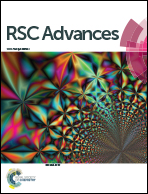Highly efficient alginate sodium encapsulated chlorpyrifos/copper(ii) Schiff base mesoporous silica sustained release system with pH and ion response for pesticide delivery
Abstract
Salicylaldehyde modified mesoporous silica (SA–MCM-41) was prepared through a co-condensation method. Through the bridge effect from copper ion, the chlorpyrifos (CH) was supported on copper(II)/Schiff base mesoporous silica (Cu–MCM-41). And then CH–Cu–MCM-41 was encapsulated by alginate sodium (ALG) to form a highly efficient sustained-release system (ALG–CH–Cu–MCM-41). The sustained-release performance of ALG–CH–Cu–MCM-41 at different pH values and different NaCl concentrations was investigated. The as-synthesized system showed significant pH responsiveness. Under the condition of pH ≤ 7, the release rate of chlorpyrifos decreased with pH increasing. Meanwhile, its release rate under weak base conditions was slightly larger than under weak acid conditions. The sustained release curves of ALG–CH–Cu–MCM-41 were consistent with the sustained release curves of CH–Cu–MCM-41 but with a smaller release rate because of the block effect from ALG. Meanwhile, the drug release rate of the sustained release system was also affected by ion concentration. Their sustained-release curves could be described by the Korsmeyer–Peppas equation.


 Please wait while we load your content...
Please wait while we load your content...